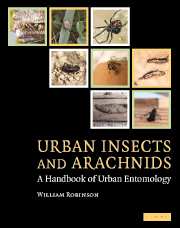Book contents
- Frontmatter
- Contents
- Preface
- Part I Urban entomology
- Part II Insects in the urban environment
- 4 Blattaria
- 5 Coleoptera
- 6 Collembola, Dermaptera
- 7 Diptera, Ephemeroptera
- 8 Hemiptera, Homoptera
- 9 Hymenoptera
- 10 Isoptera
- 11 Lepidoptera
- 12 Mantodea, Neuroptera
- 13 Orthoptera, Phasmatodea
- 14 Phthiraptera
- 15 Plecoptera, Psocoptera
- 16 Siphonaptera
- 17 Thysanoptera, Thysanura, Trichoptera
- Part III Other arthropods in the urban environment
- Family, genus, species index
- Index
- References
16 - Siphonaptera
Published online by Cambridge University Press: 06 August 2009
- Frontmatter
- Contents
- Preface
- Part I Urban entomology
- Part II Insects in the urban environment
- 4 Blattaria
- 5 Coleoptera
- 6 Collembola, Dermaptera
- 7 Diptera, Ephemeroptera
- 8 Hemiptera, Homoptera
- 9 Hymenoptera
- 10 Isoptera
- 11 Lepidoptera
- 12 Mantodea, Neuroptera
- 13 Orthoptera, Phasmatodea
- 14 Phthiraptera
- 15 Plecoptera, Psocoptera
- 16 Siphonaptera
- 17 Thysanoptera, Thysanura, Trichoptera
- Part III Other arthropods in the urban environment
- Family, genus, species index
- Index
- References
Summary
Introduction
Fleas are 0.8–5 mm long, laterally compressed, and wingless insects. The body is well-sclerotized, yellowish brown to brownish black and usually with numerous setae and bristles. The head is small and the eyes are reduced or absent; the antennae are three-segmented, clubbed, and fit into a groove on the side of the head. Legs are short, and in most species the femur is enlarged. Mouthparts are piercing–sucking; the adult stage feeds on blood. Adult fleas are obligate parasites of warm-blooded vertebrates. In some species there is a comb of large spines, the genal ctenidium, located above the mouthparts. The thorax is compact, but consists of pro-, meso-, and metathorax. The pronotum lies immediately behind the head; on the posterior margin in some species there is a comb of large spines, known as the pronotal ctenidium.
There are about 2500 described species and subspecies in this order, and these are grouped in 239 genera and 15 families. The majority of species occur on mammals, and about 100 species are found on birds. Fleas have complete metamorphosis, with a distinct egg, larva, pupa, and adult stages. Fleas have evolved as parasites of animals that have dens, burrows, or nests. The adults remain on the body of the host, and the larvae feed and develop in the nest or burrow. Larvae are elongate and resemble fly maggots; they are distinguished by scattered, long setae on the body. Larvae have chewing mouthparts, and lack eyes and legs.
- Type
- Chapter
- Information
- Urban Insects and ArachnidsA Handbook of Urban Entomology, pp. 374 - 381Publisher: Cambridge University PressPrint publication year: 2005

